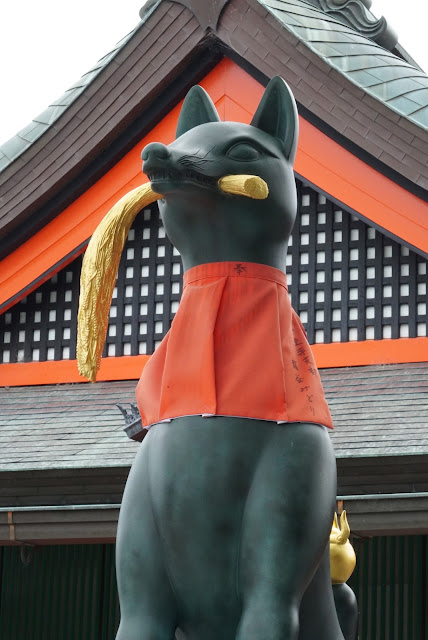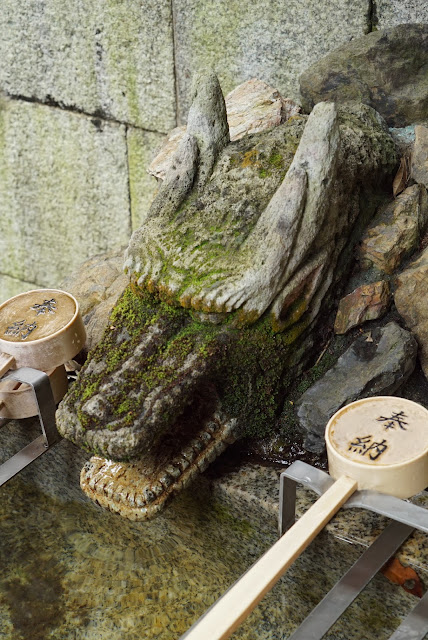Kyoto abounds in both Buddhist temples and Shinto shrines. In the context of Western religions, one of the striking things about Buddhist temples is that they almost always include a garden component. In fact, in some cases, it is the garden which is the focal point of the temple. How different from our Christian churches! I won't try to understand why this difference exists, but, needless to say, for me it makes the whole experience of visiting a religious site very different. So in Florence we spent our time visiting churches; in Kyoto we spent our time visiting temples with gardens. One can specifically seek out the most famous and spectacular of the the temples, and one can also just wander the neighborhoods, checking out many of the unrenowned yet often intriguing local temples. And there are a lot of them!
But we did visit some of the most famous ones. For example, there is the famous "Golden Pavilion" (Kinkakuji), which is an impossibly picturesque building, covered in gold and set next to a small lake and beautiful gardens. It should be noted that my pictures carefully disguise the fact that the site is extremely crowded with tourists, which certainly interferes with but does not destroy one's appreciation of the beauty of the landscape.
This path is closed to the public, which is why it is empty. Standing behind me are selfie-snapping hordes.
One of the things we learned about Buddhism during our trip was the fact that there are many, many different sects of Buddhism. Thus Zen Buddhism was founded, and then gradually many different variants of Zen Buddhism emerged, each, of course, with its own temple.
We visited one of the oldest Zen temples, Kenninji Temple, founded in 1202. This was much less crowded that the more famous ones, and you could wander at will in most of the rooms and garden. The garden featured the famous Zen style of raked gravel and rocks for contemplation.
An interior room with a screen painting:
View of an interior courtyard with a rock garden; the three stones in the middle represent Buddha and two Zen monks.
We also went to a suburb of Kyoto called Arashiyama, famous for its bamboo groves and temple gardens. The bamboo groves are visually striking;
We also visited a temple in the area, Tenryuji. It is famous for its gardens, which were laid out in the 14th century, and have stayed more or less as they were conceived. (The buildings are not the originals, and date to the 19th century.) The gardens are famous for the rocks and the concept of "borrowed" scenery, as the view of distant mountains are part of the whole plan of the garden.
More leaning and propped up trees:
In scroll paintings one often sees what I think are very stylized and exaggerated depictions of trees. When you see trees like this in person, you realize the the images are more realistic than stylized.
The trunk of the same tree:
Leaving the town of Arishiyama, we took a wonderful old two car urban train through suburban Kyoto neighborhoods. It was like riding an old trolley.
We saw a special exhibit at the Kyoto National Museum entitled "The Art of Zen". It was displayed in a beautiful new building that houses special exhibits for the museums. The older part of the museum, a building built in the 1890's, was close for renovation, so we didn't see the permanent collection. The exhibit had some wonderful landscape paintings which allowed your imagination to fill in the details. But there were also too many portraits of important people in the history of Zen Buddhism. They weren't very interesting for me.
We also visited Sanjusangen-do Temple. It is famous for its 1,001 statues of the Thousand Armed Kannon, dating from the 13th century. It is a remarkable sight, housed in a temple built at the same time, a building reputed to be the longest wooden building in the world. They are very strict about not allowing picture taking, as it is a religious site. But it is a very special and obsessive vision; each of the statues are slightly different.
Here is a picture from the internet. The statues in front are Hindu deities; I'm not quite sure what they are doing there.






















































